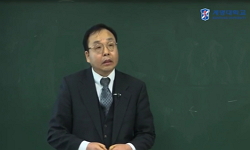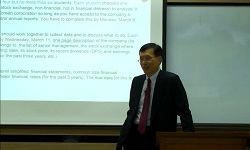Despite extreme importance in the role of companies in economic development of modern China,there had not been many studies that quantitatively analyzed management structure of such companies. Accordingly, characteristics of management structure were ...
http://chineseinput.net/에서 pinyin(병음)방식으로 중국어를 변환할 수 있습니다.
변환된 중국어를 복사하여 사용하시면 됩니다.
- 中文 을 입력하시려면 zhongwen을 입력하시고 space를누르시면됩니다.
- 北京 을 입력하시려면 beijing을 입력하시고 space를 누르시면 됩니다.

近代 中國 會社企業의 經營構造 ― 137개사 定款분석을 중심으로 ― = "Management Structure of Modern Chinese Companies ― Focusing on analysis on articles of association for 137 companies ― "
한글로보기https://www.riss.kr/link?id=A103951907
-
저자
정지호 (경희대학교)
- 발행기관
- 학술지명
- 권호사항
-
발행연도
2012
-
작성언어
Korean
-
주제어
近代中國 ; 會社企業 ; 經營構造 ; 定款 ; 章程 ; 株主總會 ; 股東總會 ; 理事會 ; 社長 ; Modern China ; company ; management structure ; articles of association ; meeting of stockholders ; Board of directors ; Chief executive officer
-
등재정보
KCI등재
-
자료형태
학술저널
-
수록면
243-273(31쪽)
-
KCI 피인용횟수
3
- 제공처
-
0
상세조회 -
0
다운로드
부가정보
다국어 초록 (Multilingual Abstract)
Accordingly, characteristics of management structure were analyzed in this study using large number of articles of association in China, while focusing on ‘公司律’ (Gongsilu) and ‘公司條例’ (Gongsitiaoli).
Analysis results can be briefly summarized as follows.
First looking at existence of general meeting of stockholders as the highest decision making body of corporations, majority of companies have regulations on general meeting of stockholders, whether they only mention regular meeting or regular and temporary meetings together. Considering the fact that even ambiguous cases showed traces on general meeting of stockholders, general meeting of stockholders in China can be seen as ‘democratically' organized in relative terms based on corporate laws. Especially,general meeting of stockholders performs an extremely important role in determining important matters for companies, such as expansion of capital size and modification of management principles.
If so, who is the majority rule conducted at general meetings? Method of exercising voting rights is an important issue for stockholders. Methods can be classified into (1) 1 vote per stock, (2) majority stockholder method, (3) minority stockholder method, (4) majority and minority stockholder method, and (5) no regulation. Overall difference among different methods is not large, and there had been many cases in which regulation on voting rights was modified depending on management conditions of companies.
With a minute trend of placing importance on moral equality, companies are slowly transforming into management systems based on capital equality principle. However, voting right entrustment system is not developed as much. Since majority of companies limit entrustment of voting rights to stockholders of corresponding company, individual rights as stockholders are still not completely objectified and rely strongly on individual character.
Board of directors is a body composed of executives that supervises management of company and hold general meeting of stockholders. Most of companies configure their board of directors by selecting members through election during general meetings (show of hands or secret ballot). Size of board was found to range between 3 and 15, proportional to capital size of the company. In contrast, minimum investment required on directors was not proportional to capital size. Ratio of investment by directors was not very high when compared to overall capital value.
Chief executive officer, an individual with actual responsibility for corporate management, was elected using diverse methods. Different methods include (1) board of directors as chief executive officer, (2) chief executive officer elected at general meetings along with members of the board, (3) chief executive officer invited by the board or initiator from stockholders or external body, and (4) dispatch of specific person.
Election at general meetings was most widely used. Chief executive officers had relatively guaranteed status compared to directors because many of them had long or no term in office. Chief executive officers have strong authorities on general corporate management and exclusive control over appointment and dismissal of executives.
Articles of association for modern Chinese companies were analyzed in this study to examine characteristics of management structure. However, since articles of association do not directly reflect actual management structure of companies, future studies shall examine actual conditions of management structure more clearly through analysis on actual examples and cases.
Despite extreme importance in the role of companies in economic development of modern China,there had not been many studies that quantitatively analyzed management structure of such companies.
Accordingly, characteristics of management structure were analyzed in this study using large number of articles of association in China, while focusing on ‘公司律’ (Gongsilu) and ‘公司條例’ (Gongsitiaoli).
Analysis results can be briefly summarized as follows.
First looking at existence of general meeting of stockholders as the highest decision making body of corporations, majority of companies have regulations on general meeting of stockholders, whether they only mention regular meeting or regular and temporary meetings together. Considering the fact that even ambiguous cases showed traces on general meeting of stockholders, general meeting of stockholders in China can be seen as ‘democratically' organized in relative terms based on corporate laws. Especially,general meeting of stockholders performs an extremely important role in determining important matters for companies, such as expansion of capital size and modification of management principles.
If so, who is the majority rule conducted at general meetings? Method of exercising voting rights is an important issue for stockholders. Methods can be classified into (1) 1 vote per stock, (2) majority stockholder method, (3) minority stockholder method, (4) majority and minority stockholder method, and (5) no regulation. Overall difference among different methods is not large, and there had been many cases in which regulation on voting rights was modified depending on management conditions of companies.
With a minute trend of placing importance on moral equality, companies are slowly transforming into management systems based on capital equality principle. However, voting right entrustment system is not developed as much. Since majority of companies limit entrustment of voting rights to stockholders of corresponding company, individual rights as stockholders are still not completely objectified and rely strongly on individual character.
Board of directors is a body composed of executives that supervises management of company and hold general meeting of stockholders. Most of companies configure their board of directors by selecting members through election during general meetings (show of hands or secret ballot). Size of board was found to range between 3 and 15, proportional to capital size of the company. In contrast, minimum investment required on directors was not proportional to capital size. Ratio of investment by directors was not very high when compared to overall capital value.
Chief executive officer, an individual with actual responsibility for corporate management, was elected using diverse methods. Different methods include (1) board of directors as chief executive officer, (2) chief executive officer elected at general meetings along with members of the board, (3) chief executive officer invited by the board or initiator from stockholders or external body, and (4) dispatch of specific person.
Election at general meetings was most widely used. Chief executive officers had relatively guaranteed status compared to directors because many of them had long or no term in office. Chief executive officers have strong authorities on general corporate management and exclusive control over appointment and dismissal of executives.
Articles of association for modern Chinese companies were analyzed in this study to examine characteristics of management structure. However, since articles of association do not directly reflect actual management structure of companies, future studies shall examine actual conditions of management structure more clearly through analysis on actual examples and cases.
참고문헌 (Reference)
1 上海社會科學院經濟硏究所, "劉鴻生企業史料 上冊" 上海人民出版社 1981
2 전인갑, "중국 근대기업의 지배구조와 合果 慣行 ― 지연망의 ‘사회자본’화 ―" 역사교육연구회 (89) : 195-225, 2004
3 中国人民银行上海市分行金融研究, "金城銀行史料" 上海人民出版社 1983
4 정지호, "近代 中國 會社企業의 制度實態 - 定款의 資本에 대한 諸 規定 分析-" 한국중국학회 (60) : 351-370, 2009
5 蘇州檔案館, "蘇州商會檔案總編 第2輯(1912~1921)" 華中師範大學出版社 1991
6 蘇州檔案館, "蘇州商會檔案總編 第1輯(1905~1911)" 華中師範大學出版社 1991
7 趙津主, "范旭東企業集團歷史資料匯編" 天津人民出版社 2006
8 張忠民, "艱難的變遷―近代中國公司制度硏究" 上海社會科學院出版社 2002
9 "申報" 上海書店 1983
10 湖北省檔案館, "漢冶萍公司檔案史料選編 (上冊)" 中國社會科學出版社 1992
1 上海社會科學院經濟硏究所, "劉鴻生企業史料 上冊" 上海人民出版社 1981
2 전인갑, "중국 근대기업의 지배구조와 合果 慣行 ― 지연망의 ‘사회자본’화 ―" 역사교육연구회 (89) : 195-225, 2004
3 中国人民银行上海市分行金融研究, "金城銀行史料" 上海人民出版社 1983
4 정지호, "近代 中國 會社企業의 制度實態 - 定款의 資本에 대한 諸 規定 分析-" 한국중국학회 (60) : 351-370, 2009
5 蘇州檔案館, "蘇州商會檔案總編 第2輯(1912~1921)" 華中師範大學出版社 1991
6 蘇州檔案館, "蘇州商會檔案總編 第1輯(1905~1911)" 華中師範大學出版社 1991
7 趙津主, "范旭東企業集團歷史資料匯編" 天津人民出版社 2006
8 張忠民, "艱難的變遷―近代中國公司制度硏究" 上海社會科學院出版社 2002
9 "申報" 上海書店 1983
10 湖北省檔案館, "漢冶萍公司檔案史料選編 (上冊)" 中國社會科學出版社 1992
11 中國國民黨中央委員會黨史史料編纂委員會, "民立報 , 中華民國史料總編"
12 "東方雜誌" 東方雜誌社 1904
13 鄭址鎬, "明淸時代 合夥의 經營形態 및 그 特質" 15 : 2001
14 中国第二歴史檔案館, "政府公報" 上海書店 1988
15 朱蔭貴, "從大生紗廠看中國早期股份制企業的特點" (3) : 2001
16 陳旭麓, "宋敎仁集" 中華書局 1981
17 天津市檔案館, "天津商會檔案匯編 (1912~1928) 1, 2, 3" 天津人民出版社 1992
18 天津市檔案館, "天津商會檔案匯編 (1903~1911) 上, 下" 天津人民出版社 1989
19 "大公報" 北京人民出版社 1980
20 商務官報局, "商務官報" 農工商部工藝局印刷科
21 章開沅, "周學熙輯" 華中師範大學出版社 1999
22 中國科學院上海經濟硏究所, "南洋兄弟煙草公司史料" 上海人民出版社 1958
23 李玉, "北洋時期股份有限公司的股份制度述論" 2006
24 李玉, "北洋政府時期股份公司的股票制度綜論" 2006
25 北京市檔案館, "北京自來水公司檔案" 北京燕山出版社 1986
26 大淸法規大全, "公司律" 宏業書局 1973
27 "公司條例" 商務印書館 1914
28 交通鐵道部交通史編纂委員會, "交通史航政編 第1冊"
29 中國第二歷史檔案館, "中華民國史檔案資料匯編 第三輯 農商(二)" 江蘇古籍出版社 1991
30 中國第二歷史檔案館, "中華民國史檔案資料匯編 第三輯 工礦業" 江蘇古籍出版社 1991
31 "中華民国国務院農商部" 1916
32 "中華全國圖書館文獻縮微中心" 天津圖書館 1993
33 河世鳳, "中國의 근대기업 발전단계에 대한 一試論―기업집단의 경영구조를 중심으로―" 10 : 1994
34 聶寶璋, "中國近代航運史資料 第2輯 下冊" 中國社會科學院出版社 2002
35 王敬虞, "中國近代工業史資料 第2輯" 科學出版社 1957
36 전인갑, "中國 近代企業과 傳統的 商慣行 ―合股慣行, 地緣網 그리고 社會資本" 동양사학회 (90) : 72-103, 2005
37 上海檔案館, "上海檔案史料總編 舊中國的股份制(1872~1949年)" 中國檔案出版社 1996
38 中國人民銀行上海市分行金融硏究所, "上海商業貯蓄銀行史料" 上海人民出版社 1990
39 河世鳳, "1930년대 上海 3대 중국기업의 독점자본적 성격에 대하여" 18 : 1994
동일학술지(권/호) 다른 논문
-
『노박집람(老樸集覽)』에 보이는 인용(引用) 서적(書籍) 고찰(1) - 「자해(字解)」와 「노걸대집람(老乞大集覽)」을 중심으로-
- 한국중국학회
- 양오진
- 2012
- KCI등재
-
- 한국중국학회
- 이정희
- 2012
- KCI등재
-
『시경』 연애시의 남녀 유락(遊樂) 풍정도(風情圖) 2 -애정표현법(愛情表現法)과 미(美)의 형상(形象)-
- 한국중국학회
- 송영주
- 2012
- KCI등재
-
- 한국중국학회
- ( In Kyung Lee )
- 2012
- KCI등재
분석정보
인용정보 인용지수 설명보기
학술지 이력
| 연월일 | 이력구분 | 이력상세 | 등재구분 |
|---|---|---|---|
| 2026 | 평가예정 | 재인증평가 신청대상 (재인증) | |
| 2020-01-01 | 평가 | 등재학술지 유지 (재인증) |  |
| 2017-01-01 | 평가 | 등재학술지 유지 (계속평가) |  |
| 2013-01-01 | 평가 | 등재 1차 FAIL (등재유지) |  |
| 2010-01-01 | 평가 | 등재학술지 유지 (등재유지) |  |
| 2008-01-01 | 평가 | 등재학술지 유지 (등재유지) |  |
| 2006-01-01 | 평가 | 등재학술지 유지 (등재유지) |  |
| 2004-01-01 | 평가 | 등재학술지 유지 (등재유지) |  |
| 2001-07-01 | 평가 | 등재학술지 선정 (등재후보2차) |  |
| 1999-01-01 | 평가 | 등재후보학술지 선정 (신규평가) |  |
학술지 인용정보
| 기준연도 | WOS-KCI 통합IF(2년) | KCIF(2년) | KCIF(3년) |
|---|---|---|---|
| 2016 | 0.48 | 0.48 | 0.49 |
| KCIF(4년) | KCIF(5년) | 중심성지수(3년) | 즉시성지수 |
| 0.49 | 0.46 | 0.841 | 0.15 |




 KCI
KCI






